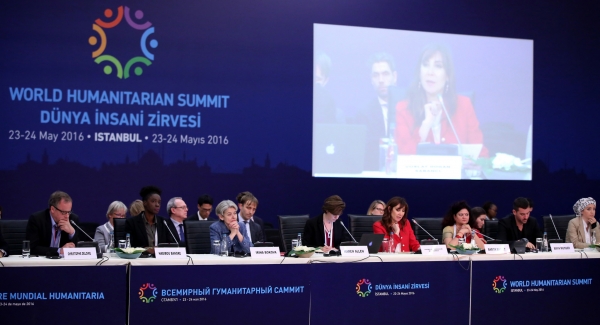The conference, held in Istanbul, Turkey, was the culmination of a three-year global consultation process which involved over 23.000 stakeholders in 153 countries and brought together the international community to reshape the way humanitarian assistance is delivered.
According to the report of the United Nations Secretary-General for the World Humanitarian Summit, entitled One Humanity: Shared Responsibilitiy, in 2015 alone 125 million people were in need of humanitarian assistance and 60 million people were forced to leave their countries to escape from wars, political instability, extreme poverty and persecution. Displaced people often become the victims of smugglers and traffickers, facing life-threatening perils at sea or while crossing deserts. Support from hosting countries is often insufficient, and asylum seekers are frequently repatriated, and therefore, back to the situation they were hoping to leave behind.
The 2030 Agenda for Sustainable Development, the programme adopted by the United Nations General Assembly in September 2015, explicitly addressed humanitarian crisis and forced displacement deriving from “global health threats, more frequent and intense natural disasters, spiralling conflict, violent extremism [and] terrorism” as an emergency that threats to reverse the development progress achieved in the past decades.
The World Humanitarian Summit was convened to demand a significant change in the ways the international community deals with humanitarian needs. The report of the UN Secretary-General for the World Humanitarian Summit called upon “global leaders to place humanity – the concern for dignity, safety and well-being of our citizens – at the forefront of all policies, strategies and decision-making”. The report urged leaders to focus on five core responsibilities:
- Core responsibility 1. The prevention of conflicts and the pursuit of political solutions to resolve them, as the United Nations first and foremost responsibility to humanity, as stated in the Charter of the Organization;
- Core responsibility 2. Upholding the norms that safeguard humanity by increasing war-prevention measures and promoting peaceful resolutions;
- Core responsibility 3. Leaving no one behind, which means empowering everyone, by working to reduce displacement, supporting refugees and migrants, ending gaps in education and fighting to eradicate sexual and gender-based violence;
- Core responsibility 4. Commitment to focus on the root causes of humanitarian crisis, and the reduction of people’s vulnerability and risk by investing in developing countries and anticipating crisis;
- Core responsibility 5. Investing in humanity, which means investing in local capacities and reducing the funding gap for humanitarian needs.
Building upon the concept of collective responsibility, the Summit aimed to provide a robust response to humanitarian crisis, by realigning the ways in which humanitarian aid is addressed by the international community, and working to find new ways to reshape the financing model. USD 20 billion are needed this year alone to cover humanitarian needs, but only USD 5 billion have been pledged so far.
Although key players agreed on the imperative necessity of addressing the challenges posed by the escalation of instability in developing countries, the Summit also faced heavy criticism. For instance, Médecins Sans Frontières (MSF) eventually pull out before the event, saying in a statement:
We no longer have any hope that the WHS will address the weaknesses in humanitarian action and emergency response, particularly in conflict areas or epidemic situations. Instead, the WHS’s focus would seem to be an incorporation of humanitarian assistance into a broader development and resilience agenda. Further, the summit neglects to reinforce the obligations of states to uphold and implement the humanitarian and refugee laws which they have signed up to.
Furthermore, several NGOs, including Save the Children, Oxfam, Action Against Hunger, expressed serious concerns on the applied methodology. In a letter to Stephen O’Brien, Under-Secretary-General for Humanitarian Affairs and Emergency Relief Coordinator of the UN Office for the Coordination of Humanitarian Affairs, it was stated that:
The humanitarian system is currently designed to deliver one-size-fits-all response that is not adapted to the different needs of different groups. This creates one of the greatest and most significant barriers to the delivery of truly impartial and accountable assistance. If the Summit is to achieve its stated objective of putting people at the centre of decision making and alleviating the suffering of the 100 million people at risk of being left behind, concrete measures are required to ensure the needs of all affected people are understood and addressed.
The 2015 resignation of the first head of the WHS secretariat, Jemilah Mahmood, who was replaced by Antoine Gérard, and the resulting methodological switch, was identified by some as a cause of destabilization of the organization.This change was also seen by observers as an alteration of the spirit of the Summit, marking the adoption of a much more centralized and less inclusive approach. Further criticism has arisen on the heavy multi-stakeholder approach, and limited space for open confrontation throughout the event.
Undoubtedly, one of the main challenges to be taken into account is the divide between humanitarian and development funding. Funding for development is usually much larger than funds destined to humanitarian emergencies. Furthermore, governments are often key actors in development projects, whereas humanitarian aid tends to rely on other forms of financing, in order to maintain its impartiality.
After the Summit, two essential questions remain to be answered. Can the humanitarian financing system be reformed? And can the funding gap for humanitarian action be filled? Commitments and initiatives launched at the Summit included a disability charter, a global alliance for urban challenges and a global alliance for humanitarian innovation. The most tangible outcome of the event was the signing by the 30 top donors and humanitarian agencies of a package of reforms, called “Grand Bargain”. Its measures include focusing on more transparency, the funding of local and national aid agencies, the reduction of duplication and management costs, the simplification and standardization of reporting methods, and more collaboration between humanitarian and development actors.
Main sources:







